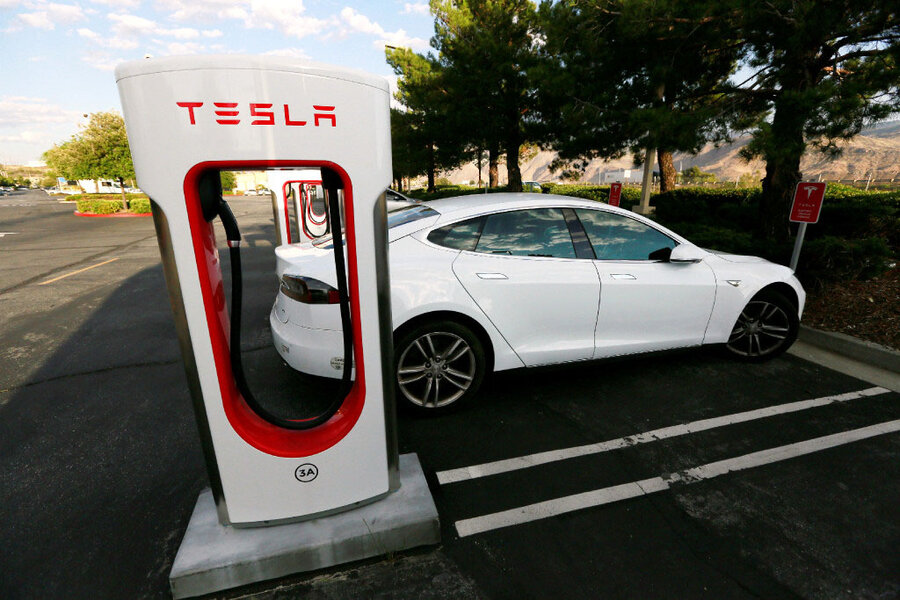If you are in the market for a new Tesla, now might be the time to buy
Loading...
Tesla doesn’t rely much on traditional advertising. If it did, your local dealership would likely be renting a blow-up AirDancer and declaring that “there has never been a better time to buy!”
On Monday, the electric car company announced that it would cut the base price of its Model S Sedan by $5,000, meaning that Tesla’s least expensive model now comes in at $69,500. Its Model 3, set to begin production later this year, will come in at a far cheaper $35,000. Buyers of both cars will also qualify for a $7,500 federal tax credit, introduced in 2010 to nurture the electric-car industry, and additional incentives in some states.
But in car dealer-speak, “these deals won’t last!” The federal tax credit begins to phase out when a firm delivers its 200,000th electric vehicle (EV), and analysts expect Tesla to reach that milestone sometime next year.
Some expect the end of this credit to spell trouble for the company. In a report published earlier this month, auto-industry analyst firm Edmunds noted that after Georgia withdrew a $5,000 EV sales credit – one of the highest in the country – sales of the electric Nissan Leaf tanked in the state. On the national level, the firm predicted that “without these credits, this market is likely to crash.”
Other auto industry analysts, however, advise taking a broader perspective. The consumer tax credit, they point out, is just one of several policies and market factors guiding Tesla and its competitors on the road to mass market.
“I don't view the tax credit as existential to Tesla,” says Salim Morsy, an advanced transport analyst at Bloomberg New Energy Finance, in a phone interview with The Christian Science Monitor. “Keep in mind that the electric vehicle tax credit is one of many schemes that support the electric vehicle industry."
“The tax credit is certainly helpful,” Mr. Morsy continues, “but Tesla's appeal is not due to the tax credit.”
Since its Roadster debuted in 2008 with a $109,000 base price, Tesla has focused on the auto market’s uppermost reaches. The average Tesla owner has an average income of $271,000, reports Clean Technica. For buyers who can afford the current price range, Morsy observes, “a $7,500 rebate is not material.”
But with the Model 3 and its $35,000 starting price, Tesla aims to grow its market share. As the Monitor reported last November, the company aims to “boost annual car production 10-fold over the next couple of years, growing from 50,000 vehicles produced in 2015 to 500,000 in 2018.” At the time, 400,000 customers had already joined a waitlist for the Model 3.
However, they haven't yet bought those cars. When the 200,000th Tesla is sold, the tax credit will begin to phase out.
In its report, Edmunds cast credits as necessary for the mass-market. During the 2011-2015 model years, the average selling price for a Nissan Leaf ranged between $30,000 and $37,000.
Noting that Tesla sales had held steady – and been much lower – in Georgia throughout this period, even as the state's credit expired and the Leaf's sales sank, Edmunds concluded that “the high-end market is able to weather price manipulations more so than the mainstream market due to their buyers' higher incomes and desire for a status vehicle.”
Bloomberg New Energy Finance’s Mr. Morsy suggests that while the Model 3 will have broader appeal, it won’t be so “mainstream” as to need a tax credit to survive. Describing it as an “entry luxury car,” on par with the BMW 3 series or the Mercedes C class, he says that “It's still in a market that's out of reach for most buyers in the US, so those buying the vehicle can probably stomach a removal of the tax credit.”
And even when the last Tesla-related IRS rebate is claimed, other modes of government support may keep driving EV costs down.
“As tax credits phase out at the federal income tax level, that's not the same as saying all subsidies for electric vehicles are being erased,” explains James Sallee, assistant professor at the University of California–Berkeley’s department of agricultural and resource economics.
“There’s these pretty substantial things, in the background, that are probably at least as potent as the tax credits.” In 2013, Resources for the Future’s Virginia McConnell and Joshua Linn wrote that “implicit subsidies to manufacturers under [federal fuel-economy] rules are roughly a couple thousand per vehicle.” Other initiatives, like California’s Zero-Emissions Vehicle program, also “create very strong incentives.”
Will these programs pay off? Professor Sallee, whose research focuses on automotive policy, says it’s hard to parse the connection between subsidies and lower car prices. But he sees one metric as key to EVs’ future: “The batteries need to get cheaper ... if you really want electric vehicles to be a mass car.”
Battery costs have already fallen from $1,000 per kilowatt-hour in 2010 to $227 today. Tesla claims to be at $190, and hopes that its new Nevada “Gigafactory” will bring costs down even further.
While Morsy cautions that Tesla could face logistical and technical challenges as the Model 3 ramps up production, he doubts that the end of one tax credit will kill the industry’s momentum. “Within the next five to seven years...,” he predicts, “electric vehicles will be priced at parity or below internal combustion engines.”
[Editor's note: This article has been updated to correctly state the Mercedes class that the Model 3 compares with]






